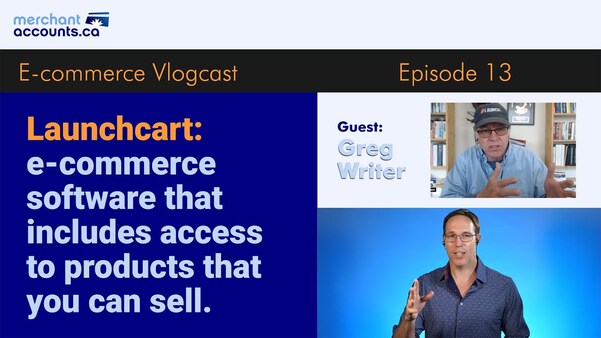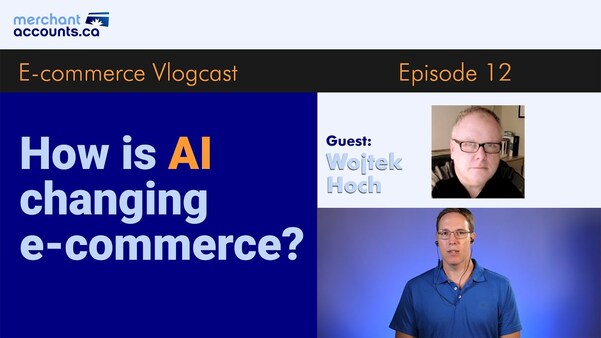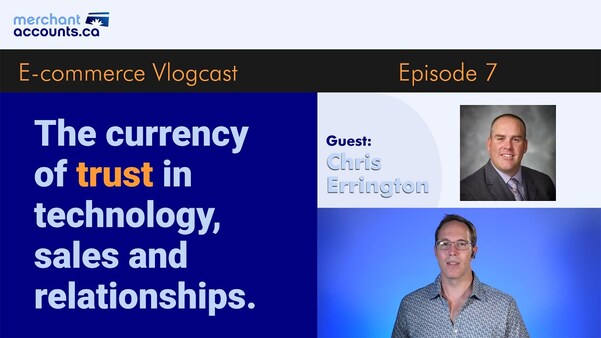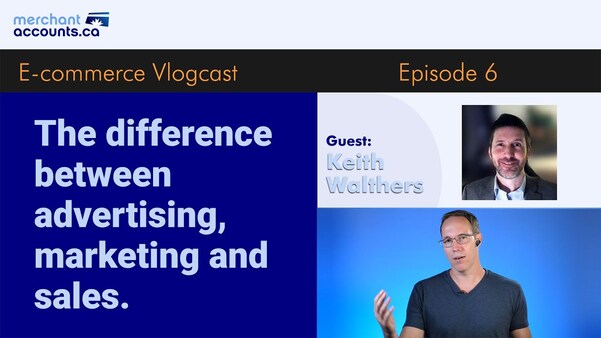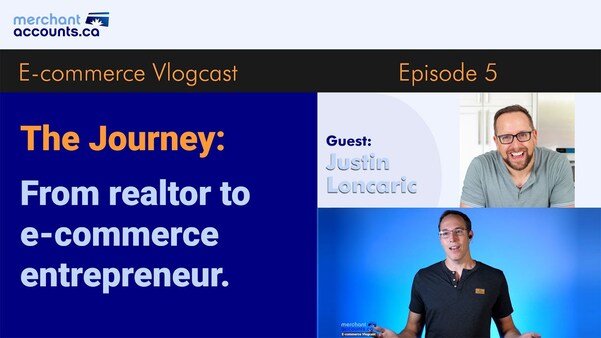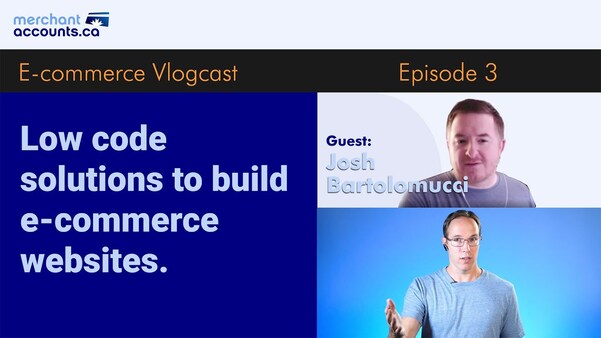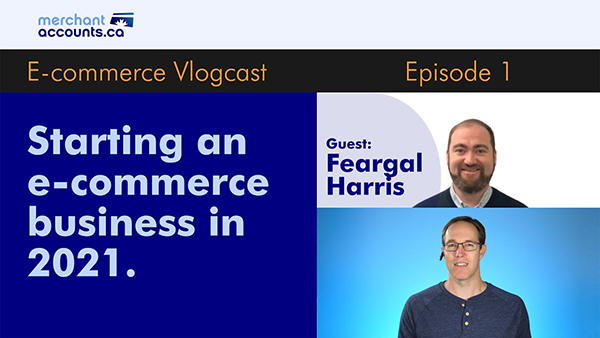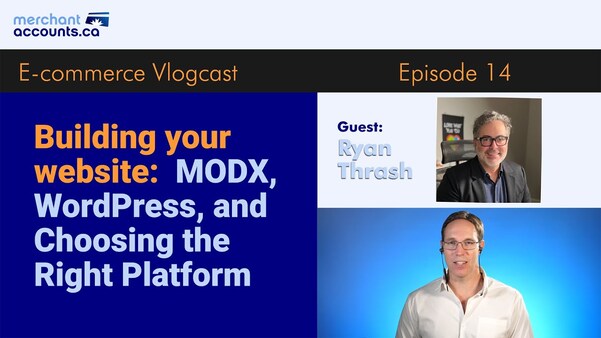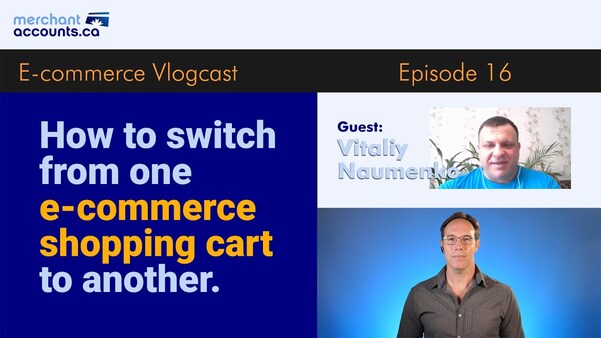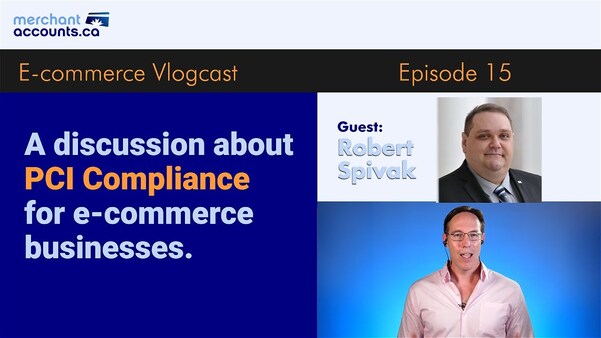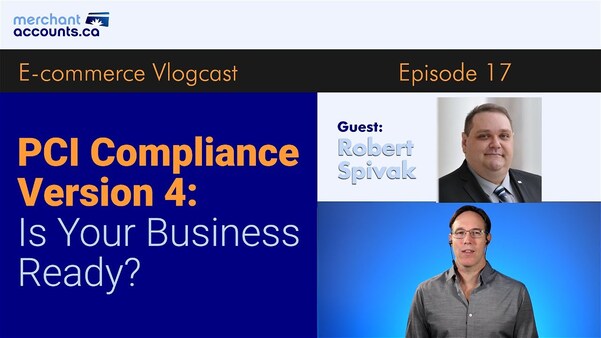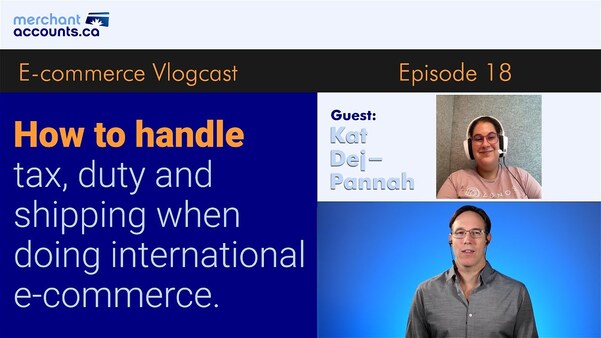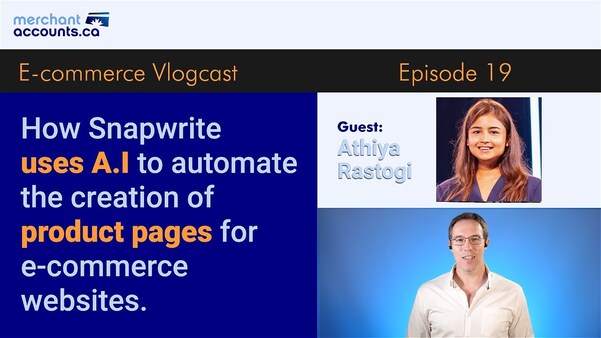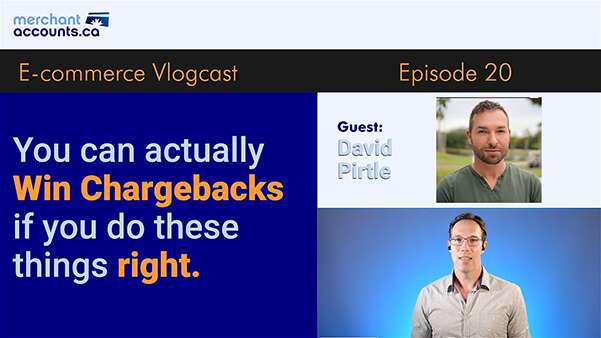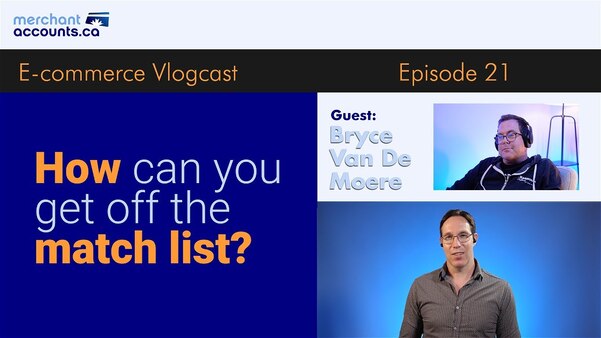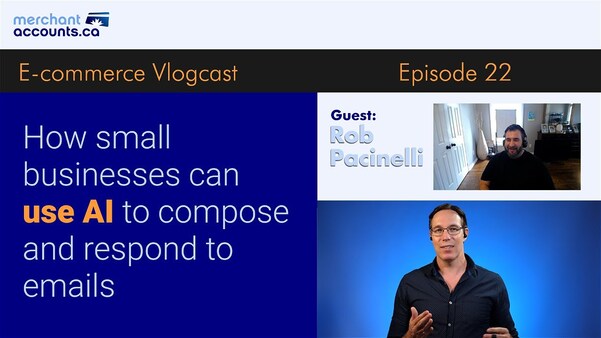Nov 1, 2021
by David Goodale
Design is incredibly important for e-commerce in 2021. Why is it so often overlooked?
(Slightly edited from video transcript for greater readability)
Key Takeaways
David Goodale:
Hello, David here at merchantaccounts.ca with our second E-commerce blog cast. And I'm have what I think is a really interesting and an often overlooked topic. Design is incredibly important in 2021 for E-commerce. So why is it so often overlooked? We're going to talk about what I mean when I say that. But I could start by like this. Like, if we talked about marketers, we said, what's the most important thing in E-commerce? Marketers could answer that in a bunch of ways it could be generating traffic or maybe they'd say, better by generating qualified leads or is it the headline and making sure that headline addresses a problem, the viewer or is it the website copy and doesn't have to build trust or is it the checkout funnel and leading the users but here's my point, what's the glue that holds all that stuff together? It's the design. And it's something I think, is way too often overlooked these days. And I think that happens, because E-commerce software platforms like Shopify, or Big commerce, or every platform, it's mature. They have or even WooCommerce, there's tons of really beautiful templates. But beautiful does not equal effective. And so that basically makes my point free. I think design is a skill. It's something I do believe, to some degree you're also born with, like I can learn to play guitar, I can learn to sing, but I'm not going to out sing Adele. And I've learned that over the years, there's things that good designers can do fairly effortlessly that I can't do with any amount of effort. So I'm talking today to Simon Cooper Cooper at Hybrid Ideas, who's a great designer that I've worked with in the past. And Simon Cooper, why don't you tell our viewers a little bit about yourself and your background?
Simon Cooper:
Sure. Thanks, David. So yeah, nice to be on here with you. So my background is I've been a I've trained as a graphic designer, about 20 years ago now, which seems like a long time now that I said, and I've been working in various forms of design ever since mostly as a graphic designer. Occasionally, I've dabbled in product design. But yeah, so I essentially graduated from Algonquin College in Ottawa, worked in Ottawa for several years, made a jump across the puddle to work in England for a year which was pretty fun. And then I came back and move to Toronto. And I've been here ever since. Worked for some ad agencies and some design firms in Toronto. And then eventually, in 2007, I branched out on my own and started life as a freelancer and I've been working as such ever since and dabbling, and a few other projects.
David Goodale:
That's right, you know, I'd say I've been doing this 20 years, my 20th anniversary for merchantaccounts.ca. Was this January? When did that happen? Oh, my gosh, yeah, sure. You feel the same way? Yeah. But so when you went to college? This is my question for you. 20 years ago, you're in college, you're learning design, I guarantee E-commerce is not front and center. And so I guess my first question is how much has design changed as a result of the internet and check funnels and commerce taking place online, as opposed to traditional print media or, you know, other places that would have historically been.
Simon Cooper:
You know, probably 10 years ago, or 15 years ago, when people had asked me what I did, and you know, what was it like designing? And at that time, people used to ask me, do you design more for printing, or digital? And I said at the time, well, when I started, it was mostly print. Literally, when I was in school, we learned we had a web design class, but web was so rudimentary at the time.
David Goodale:
Back in the day, Simon, you remember this, like you web designer was your everything. He's your coder, he's your copywriter, he's a designer. And it's like, no, that's Well, that's what it was. But it's not what it needed to be.
Simon Cooper:
Yeah, he was a webmaster.
David Goodale:
You know, that we're going to talk about my background, I went to college for design, I don't think you know that. I'll tell you about that in a second. Because that's a funny story. But sorry, please continue.
David Goodale:
Anyway, no, so yeah, so I used to, you know, design primarily for print, and digital. So I've been there from the beginning, you know, almost the very beginning of website design, to now where, you know, well, I probably designed 2% for print and the rest is digital. Everything's digital. And so, along with that, you know, websites have obviously come along, unbelievably from, you know, my early days of not being able to use curves and web design to now and anything and everything's possible. Yeah, [Inaudible 04:33]
David Goodale:
It's just all squares, exactly. That's funny. You know what I want to get to today, but I'm not going to jump the gun, as I have this theory of very unproven, it is just a personal thing that I'm wondering, because design has matured so much, and there's so many nice templates there. The people can be lazy and still have nice looking websites, but I don't think there's as effective as they could be. Don't answer that yet. Because I don't think I want to get into that quite yet. Quick start and I'm just gonna, so I went, I've said, I mentioned this, I went to school for digital media, because you're talking about back in the day, it was all webmasters stuff. So I went to school 20 some odd years ago for Digital Media Design, where you learned coding, programming audio, because it was digital media, video. And you know, I really, it actually, I didn't even really realize that at first, that I'm a horrible designer. And I truly believe not everybody's as clueless as me at design. But a lot of business owners, don't anybody can look at something nice and say, oh, yeah, no, that looks nice.
David Goodale:
But I remember back in the day, I'd be trying to make changes or upload photos, and it wouldn't work. And what I didn't know at the time is the concept of the color palette. Now, I certainly understood a color palette, like in some colors match, but what I didn't understand is you get a logo, and it has like, all the shades and grads if you follow this recipe, your stuffs gonna look right. You know it's like embarrassingly obvious. But I didn't know I think a lot of business owners, at least at the start people take for design like music. Because I write music on the side, it's, you know, really well produced or well written music, it like it sounds that probably a lot of good art looks effortless, but it's all the yeah, exactly. So I'm going to kind of jump back into it here. So here's a great question. And it's a silly question. But it's an important question, because I want you to answer it. How important is design on an E-commerce website?
Simon Cooper:
Very important.
David Goodale:
And that's a low hanging fruit question. I better. What I'm actually asking you though, is how important is font design not just to look aesthetically pleasing, but to solve a problem or like design, design is not purposeless. I always said, this is more copywriting thing. What I always say, is if your website homepage says, Welcome to xyz.com, someone's fired, right? Like, that's not what it should say that people are there for a reason. So can you apply that to like a design thought I'd love you to translate that for me.
Simon Cooper:
Yeah, no, that's, I mean, that's it is a good question. And it's 100% True. When people think of design, you know, I mean, first of all, design has a lot of different mediums, right? We could design graphically, which is what I do, we could design buildings, which is what architects do. We design products, when it comes to graphic design. I think a lot of people, you know, people are aware of graphic designers, and but they don't fully understand what happens. And to this day, you know, like I said, I've been working 20 years, and people often say, people I work with, oh, here's something can you pretty it up? Can you make this looks good?
David Goodale:
I'm pretty sure that I've said that to you.
Simon Cooper:
I don't know, I don't remember. But I hear it often. And it's a fair comment. Because you know, what we do in essence is we take information that doesn't look good. And we design it in such a way that it looks good. But along with that, and kind of more fundamentally, or more importantly, rather, is the fact that we're taking communication, and we're changing how things are communicated. And we're using layout. We're using type, we're using colors, we're using emoji. And I think that's kind of underappreciated or under, you know, it's not that well known by a lot of people. But as far as web sites and E-commerce sites go specifically, there's kind of two components there that you're talking about. There's user interface design, which is essentially the colors, the type, the layout, you know, the way the buttons look. And then there is user experience design.
Simon Cooper:
And that is how the information is presented, in which order, because it's the experience that the user has, when they're on, you know, that particular website. And so those two things have to go together and complement each other and work together. But they're different. Somebody might look at a site and say, Oh, this, you know, this is a nice looking site. It looks great. But it's a terrible experience. And it's hard to serve, hard to navigate, hard to buy a product. So
David Goodale:
Oh, right. Like, you know what, I'm gonna cut in like flash websites back in the day. Because remember, when flash kit was so cool, you could animate you could do the stuff that you couldn't do before. But that didn't mean it was super effective.
Simon Cooper:
No, exactly. And it's funny you say flash because I remember being in school and someone found a website that somebody in sort of Central America somewhere had designed that was flash, and it was incredible, but it was so slow and you know, it was the beginning of flash, they may have been paid by. Flash was Macromedia I think anyhow, so yeah. So Flash was very cool, but very, very slow and just not super user friendly.
David Goodale:
Yeah, exactly. And insecure and other challenges with it as well over the years but it sure was cool. So I think you know, you basically were talking about interface architecture navigation. But also, the part that was really interesting. My mind's always going in directions when, especially when I talk people that are like really smart at this stuff. And I'm always adding my own bit on to it. And when you're talking about it, I'm thinking about reinforcing the messaging, because you're saying you're trying to communicate things, but you're trying to communicate if it's so a good designer should be working hand in hand with a good marketer, like there should be a strategy to everything. So it's like, what is the message so there might be lots of messages. And now I'm going to come into my SEO background. And I'm like, really militant with this stuff. It's like, pick one. Because from an SEO perspective, you can't optimize for the top 50 things you want to optimize for. It's like, get real. Pick one. And so that's what I want you to do. And so from that perspective, I would, one of the things that's coming to mind is trustworthiness, like so merchant accounts, dot c is a payments website. I know it's very important for our website to look trustworthy, because we're a financial services company. And I think trustworthiness leads to conversions. When you work with clients, and you know, that it's like a commercial E-commerce type scenario. Do you sit down and think or encourage them to think about like, what are your main goals? Is that trustworthiness or education? Is that a part of the process? Or should that be a part of the process perhaps?
Simon Cooper:
You know, it should. And it's funny when you say that. I don't spend a lot of time talking to them about that. And I think it's something that I understand. And I'm probably, you know, now that you said, I probably don't do a good as good a job as I should, in communicating that to them, which is, you know, to explain why good design adds trust. Because, like you said earlier, you know, people can look at things, look at, you know, whether it's packaging, whether it's a website, and they can say, oh, you know, that looks really good. I like how that looks. But they don't know why. They just know what looks good, right? And that's a sign of good design, when people look at it, they feel comfortable in it, they know it looks good, they may not be able to explain it. But trust is a big part of that, if something doesn't look quite right, if you're going to let's say you were going to book a hotel reservation, you're going on a trip and you want to book a hotel, and you go to the site, and it's not through an Expedia or, you know, one of the travel website. And when you get to the site, it's like somebody has made their own homemade website, and it's not very good quality, you'll probably just inherently be nervous or a little bit skeptical about putting a credit card in there because it doesn't look professional. And because it doesn't look professional, you don't have that level of trust.
David Goodale:
It's totally true. It's going all the way back to like broken image links. It's like how to kill a website, which is one of the reasons it's also worked into Google's algorithm. And, like, it's really important, you know, and this is like a human thing, I'm sure you'll agree, you have one chance to make a first impression kind of in life the same as it is online, you get to the website, and it looks like garbage or something is broken. It's actually a there's something called so I do have a background in marketing. And there's something called fear of purchasing. And people won't commit until you address that whatever the fear is, it could be, will this work? Will it solve my problem? And one of the obvious ones is trustworthiness. Like, I don't even know that these guys are legitimate. You're killing yourself. And so yeah, design is so important for that and it absolutely places an impact on conversions. And I think the type of business affects it as well, you know, so I have some rental properties, and websites for those rental properties. And because I have a background and all this stuff, like they're clean, and they work, but if somebody said to me, if I had to have a broken link or a broken image, and where would I be more worried, I'd be a lot more worried on merchantaccounts.ca, then I wouldn't be on a rental property website.
David Goodale:
Right? Because you know, so it's the same type of idea. And it's interesting how you said that you don't always spend time talking clients about it, because to a degree, your job is to do what people are asking you to do. And you can kind of what he can lead a horse to water, but you can't make it drink sometimes. The way that I approach this stuff, so going with the example of merchantaccounts.ca, maybe we can do a couple more examples in a bit. But like, we want people to contact us. So when people come to our website, it's like the first thing that we make, try to make there is hey, we do we have something to do with the world of credit card processing. We try to make it clear been doing it a really long time and we're trustworthy. And then I know people usually just want to know the cost. You know, I like long copy.
David Goodale:
But a lot of people just like get to the point when we lead people there. And what I'm describing is basically I'm describing a funnel. And so can you kind of talk a little bit about how does that, maybe design tips when you're building a funnel like this? Some of the stuff I do have a background on but I don't want to assume ever everybody does like one of the things like this is classic stuff for you, this will be peer review. But like the biggest, boldest thing on the page is what the eye goes to first. And as a designer, you'll be very good. You can lead the eye where it wants to go. Can you talk a little bit about that? And also, maybe does your average customer really realize this? I'm wondering if that's the case?
Simon Cooper:
Yeah, no, I don't think customers I mean, unless they're, you know, they're like, you and I, they work in this world. I don't think they really realize it. But yeah, it's I mean, there's a lot of different use cases, people read and consume information differently. You know, that's a fact there. So for example, you like long copy, I'm a terrible reader, I skim. I only read headlines, I just try and get to the, I'm the guy who wants to praise immediately. So in designing for that, yeah, that that's one of the key features in design is okay, what's our focal point? What do we want them to see first? And how can we get them to see, you know, what we want them to see? Then maybe the headline, the maybe the features, the maybe the price, and maybe the Buy Now button?
David Goodale:
And Simon Cooper, just gonna make a point to any of the viewers. And this is such an important, none of it should be accidental. It might seem like it's knit together. But it's, what's the word I'm looking for? Like it's craft. It's engineered, very split. A good one is engineered very specifically. Exactly as you're saying.
Simon Cooper:
Yeah. Oh, no, absolutely. It has to be, in the more time and effort you put into that experience. And, you know, going back to what we were talking about earlier, about, you know, how designs key and you said, you know, this got to be a marketing team, there's got to be photography, that's good. If your product requires it, there's got to be copywriting. And copywriting is a huge part of it, too. When you take all those things and put them together, when they're done, well, they've done really well. And they're very convincing. And people's conversion rates are higher, I can, you know, I can pretty much guarantee it.
David Goodale:
Exactly. And so I guess it depends on the type of client you're working with, because I know you've worked with some really large brands and also you work with smaller companies. I guess if they have a big team, you're going be, well I'm guessing they would probably have more instruction for you. Maybe for the smaller client, especially people that are kind of new to E-commerce, you can help them along with some thoughts. It's like what's your goal? And I would think a designer would be a very important part of designing the funnel because even if, like at merchant accounts.ca, I have to decide what I want our traffic to do, which is Contact us. But I should give that to you and be like, how can you help me reinforce these messages along the way?
Simon Cooper:
Yeah, no, absolutely. Yeah. I mean, funnel is kind of everything in E-commerce. And yeah, you're right designers. I mean, there are designers who strictly do visuals. I happen to have, you know, an E-commerce business myself. So I understand a little bit more the how the funnel works. But yeah, it's kind of like a puzzle, right? There's all these pieces. If you put them together, it's good. If you're missing a piece, you're clearly missing a piece and people recognize that it doesn't look as good to them. And so it'll be reflected in your sales.
David Goodale:
I think this segues me perfectly to my next thing that I wanted to ask. So I did go to school for digital media, and I was a far better coder than I was designer, although I'm neither and I would consider myself neither nowadays. But if you're a designer or a regular person, maybe help and I think this is a device that I could benefit from myself. How can you work with a designer effectively if you're a regular person or coder, help us understand what we can do as a regular person to help make your outcome be better, you'll be more effective when it comes to delivering, for very simple like help me make this look good and work.
Simon Cooper:
Yeah, well, you some of it, you said earlier, which is, you know, what are your goals? What are you trying to achieve here? Is it you know, because E-commerce is obviously you know what we're talking about? And so people generally want sales, but in your case, like you said you want them to contact you. Now, that might not be evident for everybody in every E-commerce website. But a few things that really helped designers are, you know, clear communication, what is it that you want? What don't you want? Some boundaries or guidelines, you know, when working with bigger companies, they have really established you know, brand identities and brand guidelines. So, you can't randomly pick a font or a color and strategies.
David Goodale:
Exactly what's gonna change this Coca Cola logo to?
Simon Cooper:
I didn't do Coca Cola before. It looks awesome here, I've put it in place. So there's obviously, constraints that you have to design within which are good because it makes your job easier, especially if you're working for a big company. And then the other thing is just to kind of let us do our thing. Design is kind of a strange one because it's both creative and very sort of technical. So while we can be creative, like I said, there are constraints in for example, you know, an E-commerce site. You only have page in areas sort of this big, where you have to have a picture, you know, the product or description of the product and as much information as you can relate to people in that small space. So, yeah, by letting us do our thing, and then just discussing after, you know, we'll present something to you. And it's just a case of looking and saying. Well, here are the things I like about here are the things I don't like, and listen to our reasoning. But in most relationships, honestly, designers are, you know, while we're good at design, we don't necessarily know your business. Well we don't know your business as well as you do. So that's where collaboration is really important, right? You may say to me, Hey, Simon, I don't like that. And here's why. And I'll say, Well, I didn't think of that day, because it's not, you know, I don't understand your [Inaudible 20:47]
David Goodale:
salary you do every day. Exactly. Yeah, exactly. So collaborative. Communication. I think that's, I think that's really good. It's one of the things I struggle with. So I have been working with you guys, as you know, on just some updates recently. And like, sometimes it's hard for me because it's like, hey, Simon, I like this. Yeah. But it's just not quite right. And I'm sure you love feedback like that it's ever so helpful. But that's all I've got to work with, you know what I mean? So, okay, so I'm gonna ask this, then, what are some tips on design that you think a lot of people might benefit from knowing? And this could be anything it could be communicating with your designer? I don't know. I'm just gonna let you-
Simon Cooper:
Yeah. I mean, the first thing that, you know, designers is kind of a running joke with designers, because this is typical of clients. And I don't blame them for it, because I've kind of been on both sides. But this thing that we hear often, which is can you make the logo bigger, that's something that designer kind of joke about because this is very typical, because clients think, okay, I'm paying for this space, be it an ad, be it packaging, be it a website, less on websites, but so I want, you know, I want my brand stand, I want it to be bigger. So here's the tip, whitespace and cleanliness are your friends, people get overwhelmed by too much visual stimulation, too much information in one space. And the less you have on a page, the more likely you're going to actually communicate what you want to communicate. And a great example of that is if we think way back for people who are as old as you and I, to the first search engines, do you remember when Google came out? There was you know, there was hotpot there were all these other search engines. And they literally had their browser windows, their web pages were full of information. And somewhere on there was a field where you typed in, and where you were searching for.
David Goodale:
Having you're describing Homer Simpson's webpage, you're seeing that episode. But yeah, you know, I'm gonna cut in with my example. So a merchantaccounts.ca. Back when I was the designer, I'm going to 20 years ago, right? But I remember I had someone get me by email one times like, "David, I'm just not happy. No, there's no, you've no contact information on your website, you've no phone number, and you had to get it from my email". And so I call them and I'm like, "No, we have a phone number". And he's like, "where"?, and I'm like, "on the top right and on the right, and on the left, and in the footer, and on the bottom and in the nav menu under Contact us and about us". And he's like, Oh, I'm like, you know what, that's actually not your fault. It's my Homer Simpson website with 10 zillion links, and the you know, like, that's one of the whitespace things that I've learned because, like, I don't even, you know what people say, sometimes they know, just enough to be dangerous. I don't even know that much. But I have picked up tidbits. And one of the ones is the whitespace allows your eye to focus somewhere.
Simon Cooper:
Yeah and it's calming. And it allows you to greet like, you know, website, but that wasn't your fault, because back then that's what websites were, they were a jumble, try to get everything above the fold. And for those of you who don't speak design language, or no, the fold is a term from the newspaper, which are, we sort of still live in, where, you know, when you fold the newspaper in half and put it in a box, what you see at the top to where it's folded was given priority space. That was the best face because that's where people look when they picked it up. And so that translated to website designs, because the top of the page without scrolling is called above the fold. And that's the premium real estate where you want the most information. So web designers, webmasters used to jam as much as they could up there. And that was just how it worked. And then slowly in the last decade, you know, people started realizing a, you know user's don't mind scrolling. It's not a big deal to scroll. And it makes for a better experience. If you have the last information, let it breathe, let them sort of digest one thing at a time before presenting them another as they scroll. So yeah, that's a big one, just whitespace and simplicity.
David Goodale:
That's interesting. I remember I worked with another designer one time, I'd like to know your thoughts on it because it was really interesting to me. So I was going through revision act of the website? And they said, no, no, no, this is no good. Because your fonts and the way the something about the buttons, it's like no, no, that's like two years out. Any designer that looks at this is going to know that it's stale. And I remember thinking, but my customers aren't designers like, and he was talking literally, like, This font is hot, this font is hot, this font is hot. And I'm like, No, this is like a super clean, good looking font. Do you think that some designers can get to take like, I could see if you're a fashion brand, you know, or something like, but like a payments company, you know, I'm not trying to take over the world with my design tastes. But maybe I'm wrong about that. In fairness, I'd like to know your opinion on it.
Simon Cooper:
No, I mean, there's some validity there. But what you said, do some designers take it too far. And some and designers sometimes who have less experience or more, you know, they think about the work that they're producing for themselves, their portfolio. Do they like it? Maybe a little bit more than they should? Whereas what they should be thinking is who's the audience? What will they think? But at the same time, you know, if something's really out of date, then you know, the general public will pick that up, too. So there's a balance, you don't want to be super out of date. But at the same time, depending on your brand, you don't need to have the latest absolute everything. But that I mean, and that's why websites need to refresh, you know, it's good to refresh your website every well no, I don't know, maybe every couple of years, but at least you know, every three or four years, you need to update it because things change, colors, taste changes, fonts, usability, all that kind of stuff. So yeah, it's kind of important, but it's not the end of the world.
David Goodale:
But that's, you know, what a great segue into something I'm hoping you'd be willing to do. So I would like to go through a couple websites for examples of [Inaudible 26:53] maybe good and bad design is not like, I don't want to like burn anybody's website or anything like that. But maybe you could critique some designs. And maybe we could just pick something up. Because when I see something and you see it, I'm sure we don't see the same thing. So would you be able to do that?
Simon Cooper:
Absolutely. I would be happy to do. Okay, I'm gonna share.
David Goodale:
So awesome. So I can see you brought up Zara. I know that is a clothing company. If I'm not mistaken.
Simon Cooper:
Yeah, you are 100%? Correct.
David Goodale:
Maybe before you go, Simon Cooper, wouldn't this be a good way to do it? Because I can be the regular schmuck. And you can be the expertise here. So and by the way I shouldn't, because I do have a background in marketing and like website conversion. So I can look at this from a bunch of ways, but not from probably a proper it was certainly not from proper design way. The first thing that I noticed about that homepage when you hit it, the only thing that I noticed, well, first of all, their logo is quite big, but I guess it's because that's their brand. They're clearly promoting the studio collection. And if it wasn't for that, and if I didn't know what they did, I wouldn't know what they did to me. You're not communicating anything strong on this homepage, other than to go to the studio collection. But then again, like I don't even know what the goal is our website? Is it to make people come in store, right? Like, we don't even know what their goal really is, but I been yammering. I'd love to know what you think of this homepage.
Simon Cooper:
Yeah, no, I mean, there's good questions there. And you're right, I don't know what their goal is with the website? But my wife was on here yesterday and was frustrated. And so it made me think about it as one to pull up that. While initially this looks like a nice design, you know, we've got a big, strong, powerful image, you know, I've just been talking on and on about whitespace and is clearly whitespace around here. There's, you know, what they're doing well is they're focusing on one thing here on this homepage. You're right, to me, the logo is twice as big as it needs to be. It would just push everything up and it's a little overwhelming, but what's weird about this site is when I scroll down, there's really nothing else except the newsletter and okay, that's fine. We want people to shop or we want them to sign up to our newsletter. Fair enough. Those are those are good goals.
David Goodale:
Simon Cooper:
, where's the shopping, is that the studio collection called [Inaudible 29:21] already even see the shopping?
Simon Cooper:
Exactly. This is the thing. So it took me a little while to figure this out earlier. So I clicked on the studio collection because I want to see it obviously. And you know, there's some small copy up here the neutrals. Fall winter is our main collection. Okay, so this is new, I scroll down. Because the image I wanted I was looking at originally was this oopsies let me go back, was this red coat. You know, I'm assuming that's the studio collection because that's what it says wait on, it mailable now, so when I click on that instead it takes me to this. So I'm a little bit confused, but that's okay. [Inaudible 30:00] I don't mind scrolling. Well, here's another image, but it's in black and white. So I can't see if that's the red code I like. There's very little copy. There's tiny copy here says new plus three colors, cloth code.
David Goodale:
I've got a cut in with a comment go for, like, it's just so clear who their user base is. Because I can guarantee that my mum can't read that font. And without my glasses, I probably. So they're targeting a young, sophisticated, like, technically sophisticated user, obviously. And if anybody from Zara sees us, which I think is unlikely, but we're certainly not meaning to attack your website. But like, it's interesting. It's an interesting case study, because you're clearly doing something. So I mean, there's a above. Okay, to the right of that image is a search box to the right of that. There's looks like a view slider. What does that thing do?
Simon Cooper:
I don't know. Oh, there we go. So Okay, so interesting. So yeah, so instead of having the one item per page, let me try that again. Yeah. So instead, I mean, one, I can drag that slider, and it'll show me multiple items.
David Goodale:
I almost feel that this website is designed mobile first, with almost some compromises to the desktop experience. I just have this feeling because even that on the left to the left of the logo, the three lines, it's normally that's a mobile type of navigation. And you typically, so I feel this is a strongly mobile first website, which maybe is the right thing to do, because their customer base being young, probably browsers mostly on a mobile device.
Simon Cooper:
Yep. You're absolutely right. It makes sense. I hadn't thought of that. But yeah, no, I think you're 100%. Right. This is almost like they should have had you on a mobile phone or a desktop?
David Goodale:
You know, but I'll tell you this. And I'm not a designer. This sure is one monochrome website.
Simon Cooper:
It really is. Yeah. And it's, you know, and partly, that's the style. I think right now, black and whites, grays, whites are in very monochrome colors, you know, you scroll down a bit, then you start to see some color appear. But I just feel like even though you know, it's very stylish, it does look beautiful, in a way. But I feel like they're making it difficult for me to find what I want, which frustrates me a little bit. And it's just I feel it's a little too stylish. If I can say that, if that makes any sense.
David Goodale:
Yeah, somebody may be a designer. It totally looks nice. But maybe somebody like you said before, sometimes a designer get a little too much leeway. Right?
Simon Cooper:
Yeah, exactly. So here, I've just clicked into one of the products. And this is better, or at least in here, at least as somebody who's you know, shopped online before, I feel like now I'm in a spot that I feel more comfortable, which is a product page, you know, there's images that appear here, okay. So I can click through these, or I can scroll down. Again, the copy is very small. But I think your points well taken that this is obviously made for younger people. Over here, you know, you've got in terms of the communication hierarchy, you know, the first thing I see is the photos. And that's great. That's what they want me to see. They want me to look through the photos and fall in love with this product. The next biggest thing on the page, other than the Add to Cart button down on the bottom right, is the wool blend coat, which is the title. So that's doing good job, then slightly smaller. But in all caps, which I don't love is the description, full coat made of wool blend, etc, etc. There's some colors, there's some sizing, add to cart.
David Goodale:
I have an issue with that, like my issue there is that font. So in fairness, again, because I really want to be fair to Zara, I'm looking at your sharing on Google meet here. So it's not truly a full screen experience. But that font for the price is so small, it's almost like the fine print on an insurance policy. So it's interesting. I'm sure that this is, you know it do me a favor. I don't know if you can do. Let me see, is there a way to look at this? And you know what, maybe we don't need to look at it too much deeper, because I think you've made such interesting points. And maybe, yeah, see, there it is on mobile. And oh, yeah. See on mobile, I just have a feeling Yeah, that it's going to be better. In what, almost an interesting use case, because I don't think this happened accidentally. Let me rephrase that. We obviously know this didn't happen accidentally. And so this is where they're trying to accomplish a goal. I'm not exactly clear what it is. And it may be it's more to get people in store, make people aware of their line to come into the store to try it on. Right? Like it's hard for us to know.
Simon Cooper:
It could be a bit you're 100% correct. I mean, this is clearly a mobile first site. And that makes sense because most people visit, especially, you know, especially this demographic for these kinds of products, they will be there on their phones, but there's still some things that I think they can improve on here. Like where has all the information gone? I can't scroll down anymore. So the only thing I can do is scroll over these images, which is great. You know, I want to see the coat before I were to consider buying it. But this is the rest of the information. It's a new Wilco plan. It's $259 Add to Cart. So yeah, it's kind of bizarre how they've left out any of the features and benefits of the jacket.
David Goodale:
Yeah, you know, there's a lot of classic stuff that I think we would both argue they're not doing. They might argue if they are on unmown. There's a reason why and there might be a very good reason. But to me, at least by a traditional marketing standpoint, like, let me phrase it this way. Boy, I'm about to make a really good point. I think you'll agree with this. If merchantaccounts.ca was designed this way, it would be a travesty. My older average customer couldn't read the font. You know, that's not really clear. There's no clear messaging, there's no benefits and or anything like that. So maybe the argument is in design. Coming back to the very start first one of the very first things we said Right? In design, what are you trying to accomplish? Right? Because it should all these elements should sew together to form a real game plan. So thank you for taking me through this one. Do you have maybe one more we could do?
Simon Cooper:
I do have another one. And this is an example of, I would say a more traditional approach. This is a company in the US that makes high quality men's grooming row while razors and accessories. And what I like about this website is right off the top, I know exactly what it's about. Now, this is obviously a much smaller product line. So you know, in Zara's case, in their defense, they have a lot to communicate, they have a lot of different products, they have a lot of different audiences, men, women, probably children, whereas this is simpler. So it's easier for them to relate to us quickly what it is that they sell, but they I think they do a really good job. You know, the video is clear, it looks good. You know, as a man, I can see that ladder looks great. And then they've got one big line of coffee that says high performance grooming. So it's very clear where I am and what they're offering me right off the top, then they've got shop now button.
Simon Cooper:
You said something earlier in this discussion and you've said it to me recently, in a separate discussion about photography being really important. And whoever did this video Like, that is a beefy looking razor. He know like that photography, I'm pretty sure. Like, if I didn't have if they had to have this website, and they didn't have that asset, and they only had a static image, or maybe just an image of the razor on a white backdrop. So much less effective. So this is an example I think of this is a great asset. However they've shot and incorporated this to the site.
Simon Cooper:
Oh, yeah, no, I agree completely, you know, a picture's worth 1000 words. So if we scroll down on this one, so you know, right away, okay, so these are the products. So there's the razor, and there's some really nice effects, like when I scroll over it, you know, they show a photo of it being used in a different color, which is great. So I can instantly see, okay, you know, I can kind of see the size of it, I can see in use, and I can see that there's more colors available. And the same for this little stand, right? Oh, there it is being used. So they do a great job of preventing, even presenting, even just this far, what their products are. And here I see the prices. So at this point already, I know that I'm looking at high performance grooming products, I can see them on white background and in use, I can see that they're beautifully designed. And then I can also see the price. So if I'm not interested, and this is outside my price range, or I don't shave, whatever it is, I can leave now it's fine. But if I'm interested, and I continue, then I see. Okay, so the now they've got hair products, they've got skin products, you know-
David Goodale:
I have just gotta say, Simon, this is something that you said a couple times in our discussion. It's so clean, like the I always knows where to go every time you're on a page on this website.
Simon Cooper:
Yeah, exactly. When I design websites, what I love is in each sort of view, like this, like each sort of Screen Flow, we'll call it, if it only has one thing like this one, you could say, Okay, it's got some copy in this some images there. But I'm clearly going to be reading the copy, they won't go to this next section, okay, it's a full section. And it's just very clean and easy to consume that information. I'm not distracted by 10 other things.
David Goodale:
And the marketing guy in me wants to point out that there's testimonials in there. So there every part of this seems like they're doing something quite intentional in a good way.
Simon Cooper:
Yeah, exactly.
David Goodale:
Right there. You asked. We answered, boom. Another example.
Simon Cooper:
Yep. And then in case you weren't sure, and you're concerned, oh, free USA shipping returns. So lifetime warranty and they have a guarantee. Oh, good. I'm intrigued. So then let's go and actually check out one of the pages let's look at the razor since it's pretty cool looking. Okay, now this page what I love about it again, you know, the big beautiful image, it looks great. I mean, they've obviously done a great job of photography. I can click through here and see, you know, different ones, there's actually even a video here I can watch. There's different colors. All I need to know is right here at the top. So the name of the product is the single edge 2.0. It shows me some underneath that the star is showing it's got over 2000 reviews, their five star gives me the price, the colors and a huge button that I cannot miss that is a different color.
David Goodale:
That would be called the call to action. Whether or not?
Simon Cooper:
You got it, call to action and underneath that Oh, a little Oh, here it goes. So he says Canadian order, can tell we're in Canada. So it's telling us when our order will arrive. And then just underneath that it got some coffee that introduces the product tells you about it. And really succinctly if you want to know more what's in it, you can click on these boxes, these drop down boxes and learn as much as you want. But it's so clean and inviting. And the call to action really catches your eye.
David Goodale:
Yeah, I also and then there's more credibility, because you have like NBC and stuff on there. This is just like a textbook. And it's ticking a lot of the boxes. And compared to Zara, which I'd call more avant garde or whatever word you would use. This is ticking all of the boxes on I think what you're kind of supposed to do on a really nicely put together would say that they're trying to make people aware of what their product is and sell it.
Simon Cooper:
Yeah, exactly. Yeah.
David Goodale:
Interesting. Really interesting. Well, thanks for taking me through those examples. I thought you'd have a couple interesting examples and you certainly did so I appreciate that. So maybe what I'll do is ask a question now. And I don't know if you have one of these. But do you have a story or a reference about maybe when you work with a client and you saw a problem and how you fixed it?
Simon Cooper:
Oh, yeah, I mean, it happens fairly regularly. I mean, design. To your point earlier, I think you mentioned that, you know, a lot of people don't really understand design. No, it is, but design is actually I think if you look it up, it's actually problem solving. And so in my case is visual problem solving, and communication problem solving. And so let me think I'm trying to think of a specific example. Don't know if I can think of one offhand because there's so many because typically, that's what happens client, you know, my clients come to me and they say, We need this design. Maybe it's a website, maybe it's a logo, maybe it's a sales brochure. And, you know, the challenge is to communicate to them. Okay, well, that's great. Let's, so let's take a website, for example. Okay, so what is your core message? What is the one thing your value proposition, the one thing that you need people to know, in the case of the razor website we just looked at, it was, you know, high quality grooming tools from it. And that was the one thing they said, I think it was three or four words at the top of the homepage. So you know, it's about how do we communicate in order in a sort of communication hierarchy. So the first thing we want them to know, big and bold in their face, then for people who read that, or see that and go on, I'm interested, then underneath that, you can have a sub tag or you know, a sub headline that says, here's a bit more information about what you're interested in, and then click here to learn more. So it's really about communicating in chunks, as opposed to trying to tell the story all at once, how to entice them with good copy and tell it in small bits.
David Goodale:
Can I ask a question on that, because I think you and I think quite alike, or maybe this is just like people that, you know, have a background in this, think about, the way that I do it, as I'm always trying to think what is the customer's next concern going to be, and I try to address it just before it can coalesce or crystallize in their mind, kind of like just they did on that website, it's high quality grooming products, then this is less and more credible. And here's the references. And I'm guessing that you take a similar approach when you're looking at this type of thing.
Simon Cooper:
Yeah, and you said this at the top, but you know, there's a lot of templates out there, because this has been tested for a while, right? E-commerce has been around long enough now that there's sort of, you know, that supply website, the men's razors, or the razors, it's a great example of how we've learned some things, and we're now starting to use them. And, you know, we communicate them in such a way that they're clear, and they make sense to people. So there's sort of become a bit of a hierarchy. And yeah, I think, you know, I think it's really helped people to sort of understand that at the top, what we want to do is we want to tell them, you know, a bit about the product, but also why, why did you make this product? Why should I care? Why is it better than others? And then, you know, we as we think it through, we think, okay, so somebody is coming to the site, either through Google search, they've seen an ad. So they're either intentionally looking for razor or they happen to see an ad of yours or get told by someone and they're coming to check it out.
Simon Cooper:
So at that point, it's really you're not same this is, you know, here's our razor, buy, your saying we make the greatest razor and here's why. And so you're thinking about people who are exploring razors in general. And they're sort of considered top of funnel and then want to do is give them more information so that they're learning more about it. And then you want to give them the nitty gritty, which I showed at the bottom, which was free shipping free returns lifetime warranty. So that you're, you're answering questions, you're removing doubt. And you're removing friction from the potential of the sale.
David Goodale:
So I have a question. So I'm so curious to know your answer to this, because I did think that website was really good. And you made a point that E-commerce has been proven the templates have been tested. But my guess and I'd love to know, and you're very welcome to disagree with me, is that it's not a pure template. Because I think when you're doing something retail, the order of things changes. And that's my concern when merchants just use a template off the shelf. And they are limited with their changes, because a lot of the times when you use a Shopify template, I'm not picking on Shopify, but it's like, you know, it's kind of like, this is how it works. And it's hard to make it go in a different direction. But with them it was I think it was this is what the product does quality, trustworthiness, buy, maybe. And then like, Oh, got more questions, here's more answers and then buy again, or something. But it's not always that order. Do you think that was a customized thing? Or do you think that was an off the shelf template? Most likely.
Simon Cooper:
I think it was a customized template, because you're absolutely correct. And the good thing about templates is that anyone can have a website quickly. The bad thing about templates is, in my experience, and I've seen this happen a lot is that somebody will buy a template. And a lot of the templates are well designed. I mean, they are, you know, as a web designer, they look great. The problem is, somebody buys it, they start to mess around with it, and it doesn't look so great anymore. Because they may not be a designer and so things that they don't know about or understand, you know, come back to buy them. So that was I know, for a fact that was a customized website. And they made a lot of changes. And it's really important, you are right because every you know, every brand is different. And people have different questions, and you want to present different answers and products are different. And you know, I've been hearing a lot more about this, that people, a lot of E-commerce sites are moving more to what's called headless commerce, which is merchantaccounts.ca, where we want to build their own website the way we want to have it. And not only that, we don't want to pay as many fees to these other guys. We want to have as much money as we can and have the platform. So yeah, so there's pros and cons to both templates are great. But, you know, I think you still need a designer, and you still need to know what you're doing. And they may not be the right solution for you, as you grow. So there's sort of pros and cons there, I guess.
David Goodale:
Well, you totally I agree with you. So completely and stage. Listen, if you're launching your first website, or E-commerce website, it's so much more accessible, it's okay to have stage one, stage two, stage three and stage four. Don't go from I even tell people that's like if let's just say you had a million dollar budget for an E-commerce website, by the way, that's a pretty darn good budget for anyone. But let's just say a small midsize company had a million dollar budget, do you know what it would be? Be about 95% wasted because you don't know what your problems are, for the most part, like so. So having that first one to get you live, and then learn and improve your conversions and all that stuff. And I personally skew in a way that's probably not beneficial in some ways, because I always want custom because I don't like being roped in, but those gropes are also guides. And they help you know and so there's definitely a strong argument for both. And Simon, I think we are coming up to about our scheduled hour here. And this has been like a super, I knew it would be an interesting discussion. Before we go, maybe you could tell people where they can find you. Maybe the type of work that you're particularly good at or like doing so that we might be able to just let our viewers know.
Simon Cooper:
Yeah, no, thank you, David. Yeah, so I can. So my name is Simon Cooper, you can find my website at hybrid ideas. So it's hybrid, like a car ideas.ca. And, yeah, I mean, I'm interested in all kinds of creative work. My experience involves everything from coming up with brand strategies like helping customers, so someone's here, maybe in E-commerce delivery, from helping, you know, people or brands come up with their story and figure out what they want to say and how they want to say it through to the logo design, the brand identity. So that's all the fonts and colors and how the imagery is portrayed all the way through the websites and printed material and packaging. So pretty much the full gamut. Yeah, and hybridideas.ca is a website. So yeah, thanks for letting me plug.
David Goodale:
No problem, Simon. I'm hoping maybe you'll come back on again sometime because I'd actually like to do one in the future where we bring on like some more As an SEO and we all it'd be so interesting to do the same exercise but with even more expertise in each field but thank you so much and have it have an awesome day there.
Simon Cooper:
Thanks David.
Need professional guidance?
Contact us for a free one hour consultation.
Can I Help Lower Your Processing Fees?
If you found this content helpful, will you give me the opportunity to quote on your business?
View Rates


